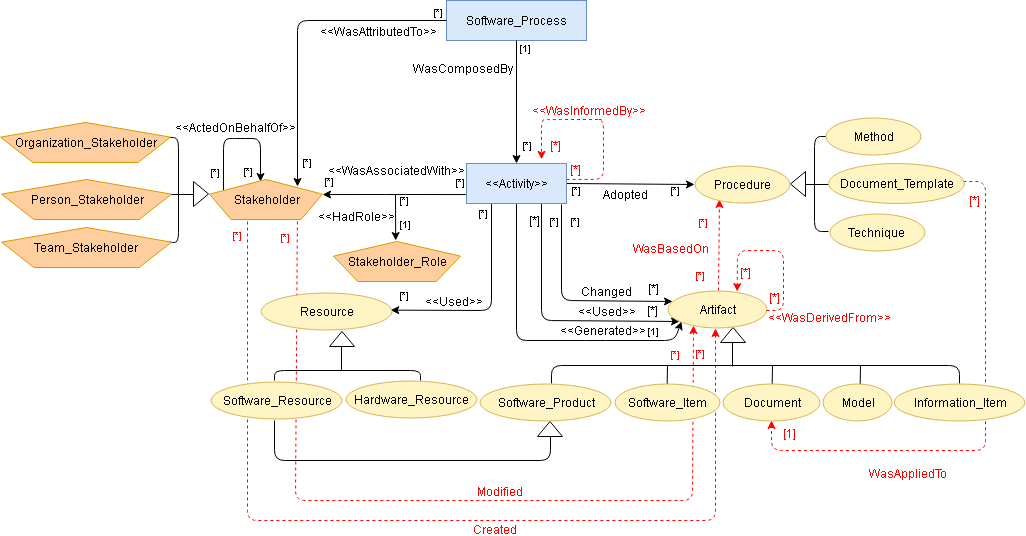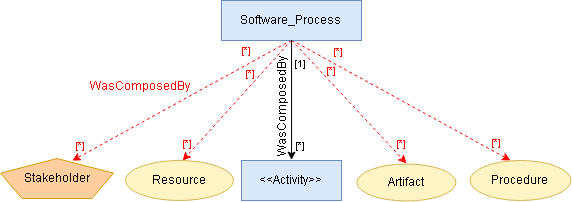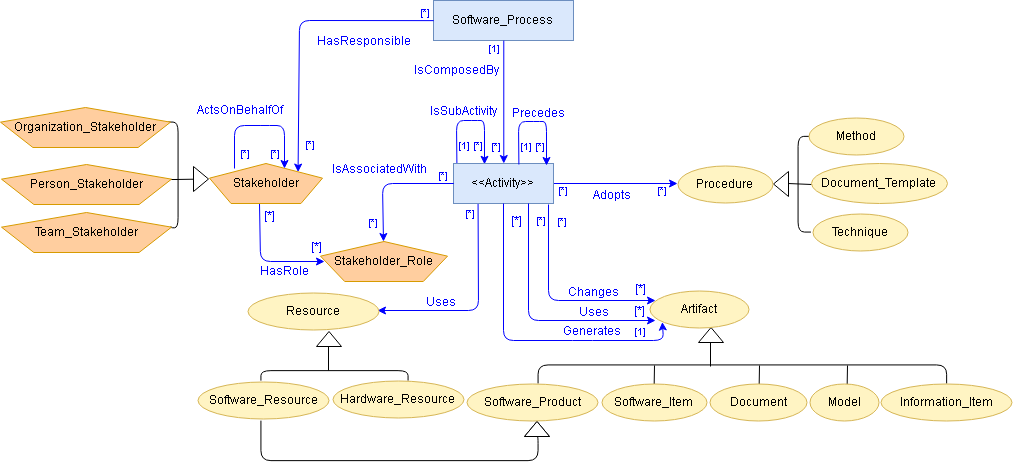1. Introduction
Provenance data is a record of the data derivation history, which enables reproducibility, results interpretation and problems diagnosis [LLC+10].
Buneman et al. [BKW01] defines provenance data as the description of the origin of the data and the process by which it passed. The capture of this origin can be made considering both the data and the process.
Provenance data can be captured prospectively and retrospectively [FKS+08]. Prospective provenance captures the steps to generate a product, allowing the registration of specifying a computational task, such as a set of processes and / or a script. Retrospective provenance captures the performed steps by a computational task, as well as environmental information used to derive a specific product, i.e. a detailed log of the task.
According to Simmhan [S07], the provenance of processes involves the description of the tasks that are part of a process. In certain cases, to obtain the information of the data generation of a given product, it is also important to register each data consumed by the process. Thus, to capture the process provenance, it is necessary to obtain a description of the implementation of all tasks effected, in order to have the information regarding the success or failure of these tasks during execution.
In order to obtain the benefits of provenance information, the capture of software process provenance data is required as well as its storage for later access and analysis. One way to analyze and check the quality of generated data from software processes is through the use of techniques and data provenance models. Thus, there are two main models proposed in the literature that deals with data provenance: OPM [MCF+11] and PROV model [PROV].
Considering the existence of different systems for the SDP execution and the lack of a standard model to capture the provenance of these processes, the PROV-SwProcess model was defined. In addition to capturing / storing these kind of provenance data, this model provides a structure that allows a better analysis from software process provenance data later.
1.1 Relation to other standards
PROV-SwProcess was developed as an extension of PROV model in order to capture software process provenance data. This extension was developed considering that PROV is more general, and do not provide all concepts related to SDP.
PROV-SwProcess uses as basis for its definition the package of Software Process Execution of the Software Process Ontology (SPO) [SPO] . This ontology stablishes a common conceptualization about the software process domain and includes processes, activities, resources, people, artifacts, and procedures.
Another extension of PROV model specification is the D-PROV [MDB+13]. It has the aim of representing process structure, i.e., to enable the storage and query using prospective provenance. It shows an example of using D-PROV in the context of scientific workflows. D-PROV was a previous version of ProvONE [VLM+14]. ProvONE is a model for scientific workflow provenance that extends PROV with its specific structure elements. This technical specification about PROV-SwProcess used the ProvONE standard as basis. It was developed in the context of DataONE Project, a large scale and federated data infrastructure for the earth sciences community. Although this model is useful in scientific workflow domain, it does not suffice for capturing and analyzing provenance in the SDP domain. For example, in ProvONE, the workflow execution corresponds to the execution of computational tasks only by software agents but, in the software process context, we need to express different types of agents, such as, person, software agent and organizations.
A preliminary proposal of PROV-SwProcess (called PROV-Process) was published in [D16]. It is an initial approach to apply the PROV model in the context of software process. PROV-SwProcess aims to incorporate the basic ideas of this work, as well as additional contributions, to derive an adequate standard that can be used in the SDP domain.
1.2 Aspects covered by PROV-SwProcess
PROV-SwProcess aims to provide the fundamental information required to understand and analyze provenance data from SDP. Considering this, it covers the prospective and retrospective provenance [FKS+08] and the essential aspects of SDP: activities, stakeholder, resource, procedure, and artifact, as proposed in [SPO]. Each of these aspects is described next.
-
Prospective provenance:
captures the steps, i.e. the procedure necessary to produce the software. It corresponds to the software development process specification, detailing all the activities (and/or subactivities)that must be carried out to generate the software. In addition, it permits to specify the responsible(s) for the process, the specific roles to perform an activity, the procedures and resources to be adopted, and the artifacts to be generated, used or modified during the process execution. In order to enable a degree of abstraction, this specification does not need to be executable.
-
Retrospective provenance:
comprises the activities that were executed in the generation of the software, considering the adopted procedure, the artifacts generated, altered, and / or used, the stakeholders involved, and the resources used during the process execution. This information can be recorded at varying degrees of detail and granularity, depending on how the recording is treated on the software process development system.
-
Activity:
deals with the process activities used to create and/or maintain software and how they compose the software development process
-
Stakeholder:
refer to organizations, persons, projects, or teams acting or interesting in the software process activities.
-
Resource:
involve hardware equipments and software products used by the software process activities.
-
Procedure:
relate to methods, techniques and document templates adopted by the software process activities.
-
Artifact:
represent different types of objects produced, changed, and used in process activities.
4. PROV-SwProcess Inference Rules
PROV model presents in its documentation some constraints [PROV-Constraints]. They define when a PROV instance is valid, ensuring that this instance represents a consistent history of objects and their interactions are safe to use for logical reasoning or for other types of analysis. Part of this document describes the inferences that may be used on provenance data.
Considering an inference as a rule that can be applied to PROV-SwProcess instances to add new PROV-SwProcess statement, PROV-SwProcess model also specifies its inference rules. In addition to specifying them, they are also implemented in the PROV-SwProcess Ontology.
Fifteen inferences rules have been defined and specified using the Semantic Web Rule Language (SWRL) [HPB+04], specifically to the SDP domain. They can be divided into 7 groups (detailed in the following):
- Created
- Modified
- WasBasedOn
- WasAppliedTo
- WasDerivedFrom
- WasInformedBy
- WasComposedBy
All the proposed inferences have the form:
IF A1 and ... and Ap THEN there exists y1...ym such that B1 and ... and Bk
That means:
? x1,....,xn. A1 ? ... ? Ap ? ? y1...ym . B1 ? ... ? Bk, where x1...xn are the free variables of the inference
After the inference definition, an example of its operation is presented and also how it was implemented in the ontology using SWRL.
4.1 Created
IF wasAssociatedWith(_ass; ac,sta,_attrs1) and generated(_gen; ac,art,_attrs2) THEN there exists _id such that created(_id; sta,art,[]).
This inference states that if an activity ac was associated with a stakeholder sta and this activity ac generated an artifact art, the relation created between the stakeholder sta and the artifact art can be inferred. To express this inference, a restriction using a SWRL rule was created in the ontology:
prov:wasAssociatedWith(?ac, ?sta) ^ prov:generated(?ac, ?art) -> provswprocess:created(?sta, ?art)
Figure 4?
shows part of the example used to explain PROV-SwProcess model with its possible inferences. Even if there is no explicit and direct relation in the provenance data between Mary and Payment_Test_Cases, we can infer, using the rule presented by Inference 1, that Mary created Payment_Test_Cases.

Figure 4
?:
PROV-SwProcess Inferences Example
4.2 Modified
IF wasAssociatedWith(_ass; ac,sta,_attrs1) and changed(_cha; ac,art,_attrs2) THEN there exists _id such that modified(_id; sta,art,[]).
This inference states that if an activity ac was associated with a stakeholder sta and during this activity ac an artifact art was changed, the relation modified between the stakeholder sta and the artifact art can be inferred. To express this inference, a restriction using a SWRL rule was created in the ontology:
prov:wasAssociatedWith(?ac, ?sta) ^ provswprocess:changed(?ac, ?art) -> provswprocess:modified(?sta, ?art)
Figure 4?
shows that even if there is no explicit and direct relation in the provenance data between Simon and Accounting_System, we can infer, using the rule presented by Inference 2, that Simon modified the Accounting_System.
4.3 WasBasedOn
IF adopted(_adp; ac,pro,_attrs1) and generated(_gen; ac,art,_attrs2) THEN there exists _id such that wasBasedOn(_id; art,pro,[]).
IF adopted(_adp; ac,pro,_attrs1) and changed(_cha; ac,art,_attrs2) THEN there exists _id such that wasBasedOn(_id; art,pro,[]).
This inference states that if an activity ac adopted a procedure pro and this same activity ac generated or changed an artifact art, the relation wasBasedOn can be inferred between the artifact art and the procedure pro. To express this inference, two specific restrictions using SWRL rules were created in the ontology:
provswprocess:adopted(?ac, ?pro) ^ prov:generated(?ac, ?art) -> provswprocess:wasBasedOn(?art, ?pro)
provswprocess:adopted(?ac, ?pro) ^ provswprocess:changed(?ac, ?art) -> provswprocess:wasBasedOn(?art, ?pro)
Figure 4?
shows that even if there is no explicit and direct relation in the provenance data between Payment_Test_Cases and Test_Cases_Template, we can infer, using the rules presented by Inference 3, that Payment_Test_Cases wasBasedOn Test_Cases_Template. Another inference of this same type can be seen between Requirements_Document and Software_Cost_Reduction.
4.4 WasAppliedTo
IF adopted(_adp; ac,dt,_attrs1) and generated(_gen; ac,d,_attrs2) THEN there exists _id such that wasAppliedTo(_id; dt,d,[]).
IF adopted(_adp; ac,dt,_attrs1) and changed(_cha; ac,d,_attrs2) THEN there exists _id such that wasAppliedTo(_id; dt,d,[]).
This inference states that if an activity ac adopted a document template dt (a specific type of procedure) and this same activity ac generated or changed a document d (a specific type of artifact), the relation wasAppliedTo can be inferred between the document template dt and the document d. To express this inference, two specific restrictions using SWRL rules were created in the ontology:
provswprocess:adopted(?ac, ?dt) ^ prov:generated(?ac, ?d) -> provswprocess:wasAppliedTo(?dt, ?d)
provswprocess:adopted(?ac, ?dt) ^ provswprocess:changed(?ac, ?d) -> provswprocess:wasAppliedTo(?dt, ?d)
Figure 4?
shows that even if there is no explicit and direct relation in the provenance data between Test_Cases_Template and Payment_Test_Cases, we can infer, using the rules presented by Inference 4, that Test_Cases_Template wasAppliedTo Payment_Test_Cases.
4.5 WasDerivedFrom
IF used(_use; ac,art1,_attrs1) and generated(_gen; ac, art2, _attrs2) THEN there exists _id such that wasDerivedFrom(_id; art2, art1, attrs).
This inference states the derivation between two artifacts if an activity ac has used an artifact art1 and this same activity generates a new artifact art2. To express this inference, a restriction using a SWRL rule was created in the ontology.
prov:used(?ac, ?art1) ^ prov:generated(?ac, ?art2) -> prov:wasDerivedFrom(?art2, ?art1)
When this inference was implemented in the SDP domain, it allowed inferring when an artifact was derived from another, although this relation was not explicit in the provenance data. As can be seen in Figure 4?, we can infer that Payment_Test_Cases wasDerivedFrom Requirements_Document.
4.6 WasInformedBy
IF used(_use; ac2,art,_attrs1) and generated(_gen; ac1,art,_attrs2) THEN there exists _id such that wasInformedBy(_id; ac2,ac1,[]).
IF changed(_cha; ac2,art,_attrs1) and generated(_gen; ac1,art,_attrs2) THEN there exists _id such that wasInformedBy(_id; ac2,ac1,[]).
This inference states that if an activity ac2 used or changed an artifact art that was generated by an activity ac1, the relation wasInformedBy can be inferred between ac2 and ac1, stating a dependency between these activities. To express this inference, two specific restrictions using SWRL rules were created in the ontology:
prov:used(?ac2, ?art) ^ prov:generated(?ac1, ?art) -> prov:wasInformedBy(?ac2, ?ac1)
provswprocess:changed(?ac2, ?art) ^ prov:generated(?ac1, ?art) -> prov:wasInformedBy(?ac2, ?ac1)
Figure 4?
shows that even if there is no explicit and direct relation in the provenance data between the activities Codification and New_Resource_Specification, we can infer, using the rules presented by Inference 6, that Codification wasInformedBy New_Resource_Specification.
4.7 WasComposedBy
IF wasComposedBy(_wcb; sp,ac,_attrs1) and wasAssociatedWith(_ass; ac,sta,_attrs2) THEN there exists _id such that wasComposedBy(_id; sp,sta,[]).
IF wasComposedBy(_wcb; sp,ac,_attrs1) and changed(_cha; ac,art,_attrs2) THEN there exists _id such that wasComposedBy(_id; sp,art,[]).
IF wasComposedBy(_wcb; sp,ac,_attrs1) and generated(_gen; ac,art,_attrs2) THEN there exists _id such that wasComposedBy(_id; sp,art,[]).
IF wasComposedBy(_wcb; sp,ac,_attrs1) and used(_use; ac,art,_attrs2) THEN there exists _id such that wasComposedBy(_id; sp,art,[]).
IF wasComposedBy(_wcb; sp,ac,_attrs1) and used(_use; ac,res,_attrs2) THEN there exists _id such that wasComposedBy(_id; sp,res,[]).
IF wasComposedBy(_wcb; sp,ac,_attrs1) and adopted(_adp; ac,pro,_attrs2) THEN there exists _id such that wasComposedBy(_id; sp,pro,[]).
This inference is only useful when more than one process instance is being analyzed. It brings all the Stakeholders, Resources, Artifacts, and Procedures of a given SDP instance. To express this inference, the following restrictions using SWRL rules were created in the ontology:
provswprocess:wasComposedBy(?sp, ?ac) ^ prov:wasAssociatedWith(?ac, ?sta) -> provswprocess:wasComposedBy(?sp, ?sta)
provswprocess:wasComposedBy(?sp, ?ac) ^ provswprocess:changed(?ac, ?art) -> provswprocess:wasComposedBy(?sp, ?art)
provswprocess:wasComposedBy(?sp, ?ac) ^ prov:generated(?ac, ?art) -> provswprocess:wasComposedBy(?sp, ?art)
provswprocess:wasComposedBy(?sp, ?ac) ^ prov:used(?ac, ?art) -> provswprocess:wasComposedBy(?sp, ?art)
provswprocess:wasComposedBy(?sp, ?ac) ^ prov:used(?ac, ?res) -> provswprocess:wasComposedBy(?sp, ?res)
provswprocess:wasComposedBy(?sp, ?ac) ^ provswprocess:adopted(?ac, ?pro) -> provswprocess:wasComposedBy(?sp, ?pro)
Figure 4?
shows that even if there is no explicit and direct relation in the provenance data between the SDP New_Resource_Development and all the Stakeholders, Resources, Artifacts, and Procedures, using this inference is possible to obtain a direct association between them.



